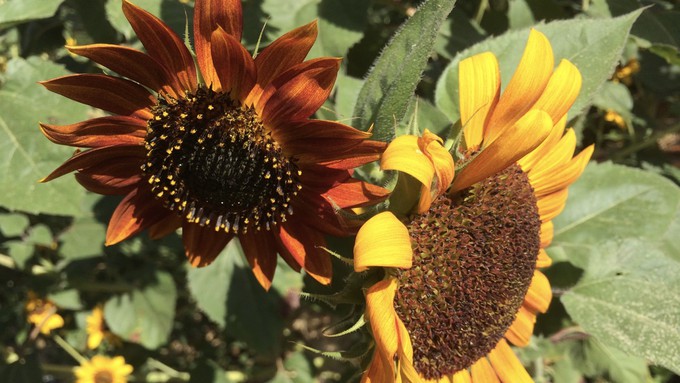
Heat arrives and so does vegetable planting time

It's time to plant sunflowers -- the bees are counting on you! Kathy Morrison
After an unusually cool spring, summer arrived early this weekend with temperatures in the high 90s.
According to the National Weather Service, this welcome warm-up follows several chilly months.
“Today will be a hot day, with many locations in the Valley reaching the upper 90s, but did you know 2023 has been unusually cool so far?” tweeted the NWS Sacramento office on Saturday. “Average temperatures for Downtown Sacramento since January 1st have been the coolest since 2011.”
The month of May averages highs of about 80 degrees in Sacramento. This coming week will be well above that norm with most days in the low 90s and sunny, gradually cooling back into the 80s by next week.
Just as important, overnight lows aren’t that low; they’re on the warm side, too. We’ll stay above 57 degrees every night this week. Average lows for this time of year: 51 degrees.
That night-time warmth will heat soil and get roots growing – and plants sprouting fast.
In other words, it’s summer vegetable planting time. Get those tomatoes – and peppers, eggplant, squash, melons, etc. – in the ground.
Don’t forget to water. Our forecast is not only warm, it’s totally dry. Seedlings need moisture. Deep watering will help build strong roots and healthy plants.
* When setting out tomato seedlings, pinch off any flowers on new transplants to make them concentrate on establishing roots instead of setting premature fruit.
* Direct-seed melons, cucumbers, summer squash, corn, radishes, pumpkins and annual herbs such as basil.
* In the flower garden, direct-seed sunflowers, cosmos, salvia, zinnias, marigolds, celosia and asters. You also can transplant seedlings for many of the same flowers.
* Plant dahlia tubers. Other perennials to set out include verbena, coreopsis, coneflower and astilbe.
* Transplant petunias, marigolds and perennial flowers such as astilbe, columbine, coneflowers, coreopsis, dahlias, rudbeckia and verbena.
* Keep an eye out for slugs, snails, earwigs and aphids that want to dine on tender new growth.
* Feed summer bloomers with a balanced fertilizer.
* For continued bloom, cut off spent flowers on roses as well as other flowering plants.
* Put your veggie garden on a regular diet. Set up a monthly feeding program, and keep track on your calendar. Make sure to water your garden before applying any fertilizer to prevent “burning” your plants.
* As spring-flowering shrubs finish blooming, give them a little pruning to shape them, removing old and dead wood. Lightly trim azaleas, fuchsias and marguerites for bushier plants.
* Run the sprinklers early in the morning – before 8 a.m. if possible – to conserve water and minimize plant diseases.
* Add mulch to the garden to help keep that precious water from evaporating. Mulch also cuts down on weeds. But don’t let it mound around the stems or trunks of trees or shrubs. Leave about a 6-inch to 1-foot circle to avoid crown rot or other problems.
Comments
0 comments have been posted.Sacramento Digs Gardening to your inbox.
Sites We Like
Garden Checklist for week of May 5
Survey your garden after the May 4 rainstorm. Heavy rain and gusty winds can break the neck of large flowers such as roses. Also:
* Keep an eye on new transplants or seedlings; they could take a pounding from the rain.
* Watch out for powdery mildew. Warmth following moist conditions can cause this fungal disease to “bloom,” too. If you see a leaf that looks like it’s dusted with powdered sugar, snip it off.
* After the storm, start setting out tomato transplants, but wait on the peppers and eggplants (they want warmer nights). Pinch off any flowers on new transplants to make them concentrate on establishing roots instead of setting premature fruit.
* Trim dead flowers but not leaves from spring-flowering bulbs such as daffodils and tulips. Those leaves gather energy to create next year's flowers. Also, give the bulbs a fertilizer boost after bloom.
* Pinch chrysanthemums back to 12 inches for fall flowers. Cut old stems to the ground.
* Mulch around plants to conserve moisture and control weeds.
* From seed, plant beans, beets, cantaloupes, carrots, corn, cucumbers, melons, pumpkins, radishes and squash.
* Plant onion sets.
* In the flower garden, plant seeds for asters, cosmos, celosia, marigolds, salvia, sunflowers and zinnias. Transplant petunias, zinnias, geraniums and other summer bloomers.
* Plant perennials and dahlia tubers for summer bloom.
* Don’t wait; plant summer bulbs, such as gladiolus and tuberous begonias.
* Harvest cabbage, lettuce, peas and green onions.